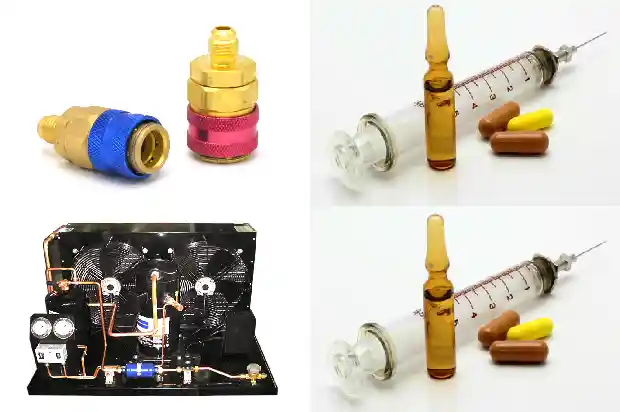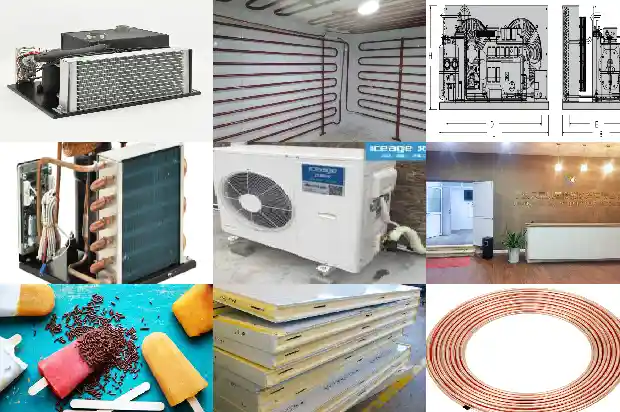Common Fault Causes and Solutions of Cold Storage Systems
2025-03-03
- High Suction Temperature
High suction temperature - mainly caused by an increase in the suction superheat. It should be noted that a high suction temperature does not mean a high suction pressure, because the suction is superheated steam.
Under normal circumstances, the cylinder head of the compressor should be half cold and half hot. If the suction temperature is too high, the entire cylinder head will be hot. If the suction temperature is higher than the normal value, the discharge temperature will also increase accordingly.
The main reasons for the high suction temperature are:
(1) Insufficient refrigerant charge in the system. Even if the expansion valve is opened to the maximum, the liquid supply will not change. In this way, the refrigerant vapor is superheated in the evaporator, causing the suction temperature to rise.
(2) The expansion valve opening is too small. This results in an insufficient circulation of the refrigerant in the system. The amount of refrigerant entering the evaporator is small, the degree of superheat is large, and thus the suction temperature is high.
(3) The filter screen at the expansion valve port is blocked. The liquid supply in the evaporator is insufficient, the amount of refrigerant liquid decreases, and a part of the evaporator is occupied by superheated steam. Therefore, the suction temperature rises.
(4) Other reasons causing the high suction temperature. For example, poor thermal insulation of the return air pipeline or an overly long pipeline can all lead to a high suction temperature. - Low Suction Temperature
Low suction temperature - mainly caused by a large liquid supply to the evaporator, resulting in a low suction superheat.
(1) Excessive refrigerant charge. It occupies part of the volume inside the condenser, increasing the condensing pressure, and the amount of liquid entering the evaporator increases accordingly. The liquid in the evaporator cannot be completely vaporized, causing the gas sucked into the compressor to contain liquid droplets. In this way, the temperature of the return air pipeline decreases, but the evaporation temperature remains unchanged because the pressure has not decreased, and the superheat decreases. Even if the expansion valve is closed slightly, there will be no significant improvement.
(2) The expansion valve opening is too large. Due to the loose binding of the temperature sensing element, a small contact area with the return air pipe, or the temperature sensing element not being wrapped with thermal insulation material or being wrapped in the wrong position, etc., the temperature measured by the temperature sensing element is inaccurate and close to the ambient temperature, causing the opening degree of the expansion valve to increase, resulting in an excessive liquid supply.
Reasons for the compressor frosting:
Reason 1: As mentioned above.
Reason 2: Insufficient refrigerant charge will cause frosting from the evaporator all the way to the compressor.
Reason 3: Due to external reasons, the refrigerant does not evaporate sufficiently or even does not evaporate in the evaporator.
At this time, there will be severe frosting, and even wet compression may occur.
- Abnormal Discharge Temperature
Abnormal discharge temperature - influencing factors: adiabatic index, compression ratio, suction temperature. The compressor discharge temperature can be read from the thermometer on the discharge pipeline. It is related to the adiabatic index of the refrigerant, the compression ratio (condensing pressure/evaporation pressure), and the suction temperature. The higher the suction temperature and the larger the compression ratio, the higher the discharge temperature, and vice versa.
When the suction pressure remains unchanged and the discharge pressure increases, the discharge temperature rises; if the discharge pressure remains unchanged and the suction pressure decreases, the discharge temperature also rises. Both of these situations are caused by an increase in the compression ratio. Too high a condensing temperature and discharge temperature are unfavorable for the operation of the compressor and should be prevented. An excessively high discharge temperature will make the lubricating oil thin or even carbonize and coke, thus deteriorating the lubrication conditions of the compressor.
The level of the discharge temperature is directly proportional to the compression ratio (condensing pressure/evaporation pressure) and the suction temperature. If the superheat temperature of the suction is high and the compression ratio is large, the discharge temperature will also be high. If the suction pressure and temperature remain unchanged, when the discharge pressure increases, the discharge temperature also increases.
The main reasons for the increase in the discharge temperature are:
(1) High suction temperature.
The discharge temperature of the refrigerant vapor after compression is also relatively high.
(2) Increase in the condensing temperature. The condensing pressure is then high, resulting in an increase in the discharge temperature.
(3) The discharge valve plate is broken. The high-pressure steam is repeatedly compressed, causing the temperature to rise. The cylinder and the cylinder head become hot to the touch, and the reading on the thermometer on the discharge pipeline also increases.
The actual factors affecting the increase in the discharge temperature are: low intermediate cooling efficiency, or too much scale in the intercooler affecting heat transfer, then the suction temperature of the subsequent stage will inevitably be on the high side, and the discharge temperature will also rise. Leakage of the air valve and the piston ring not only affects the increase in the discharge temperature but also changes the interstage pressure. As long as the compression ratio is higher than the normal value, the discharge temperature will increase. In addition, for water-cooled machines, lack of water or insufficient water volume will both cause the discharge temperature to rise. Abnormal condensing pressure and a decrease in the discharge pressure. - High Discharge Pressure
High discharge pressure - mainly caused by a high condensing pressure, rather than the reason of the compressor itself.
The discharge pressure generally corresponds to the level of the condensing temperature. Under normal circumstances, the discharge pressure of the compressor is very close to the condensing pressure.
When the condensing pressure rises, the discharge temperature of the compressor also rises. The compression ratio of the compressor increases, and the volumetric efficiency decreases, thus reducing the refrigeration capacity of the compressor. The power consumption increases. If the discharge temperature is too high, it will increase the consumption of the compressor lubricating oil, make the oil thin, and affect the lubrication; when the discharge temperature is close to the flash point of the compressor oil, it will also cause part of the lubricating oil to carbonize and accumulate at the suction and discharge valve ports, affecting the sealing performance of the valves.
Lowering the temperature of the cooling medium can make the condensing temperature drop, and the condensing pressure will also drop accordingly, but this is limited by environmental conditions and is difficult to be artificially selected. Increasing the flow rate of the cooling medium can lower the condensing temperature slightly (this method is mostly used). However, the flow rate of the cooling water or air should not be unilaterally increased, because this will increase the power of the cooling water pump, fan, and motor, and a comprehensive consideration should be made.
A high discharge pressure will increase the compression work and reduce the volumetric efficiency, thus reducing the refrigeration efficiency.
The main reasons for this failure are:
(1) Small flow rate and high temperature of the cooling water (or air);
(2) There is air in the system, increasing the condensing pressure;
(3) Excessive refrigerant charge, with the liquid occupying the effective condensing area;
(4) The condenser has not been repaired for a long time, and the dirt on the heat transfer surface is serious, which can also lead to an increase in the condensing pressure. The presence of scale also has a great impact on the condensing pressure. - Low Discharge Pressure
Low discharge pressure - mainly caused by a small or even stopped refrigerant flow in the pipeline of the refrigeration system.
Although the phenomenon of low discharge pressure is manifested at the high-pressure end, the reasons mostly occur at the low-pressure end.
The reasons are: ice blockage or dirt blockage of the expansion valve, and blockage of the filter, etc., which will inevitably cause both the suction and discharge pressures to drop.
Related Articles
- Common Fault Causes of Totally Enclosed Refrigeration Compressors
- Common Fault Causes and Replacement of Multi-connected Unit Compressors
- How to Inspect and Troubleshoot the Faults of the Control Valve in the Cold Storage?
- Common Faults in Refrigeration Systems and Handling Methods
- What Are the Common Causes of High - pressure Faults in Chillers?
- Basic Faults and Preventive Maintenance of Water - cooled Units
- Composition and Common Faults of Screw Refrigeration Compressors
- Common Faults and Solutions of Central Air - conditioning Chiller Units
- Common Faults of Industrial Chillers
- Common Faults and Corresponding Solutions of Chillers During Use
- Analysis and Troubleshooting of Common Faults in Air - source Heat Pumps
- Maintenance Methods for Faults in Screw Refrigeration Air - conditioner Compressors
- Common Faults and Troubleshooting Methods of the Moving Mechanism of Piston Compressors
- Analysis of Common Faults in Compressor Overcurrent and Burnout
- What are the reasons for the inactivity of the automotive air conditioning compressor? What are the common faults?
- Common Faults of HVAC Fan Coil Units
- Common Fault Repair of Frozen Cold Storage
- Common Operating Faults and Treatment Methods of Centrifugal Compressors
